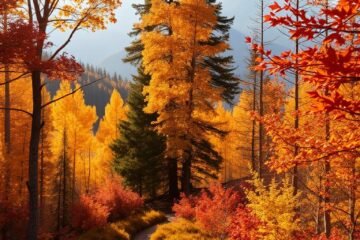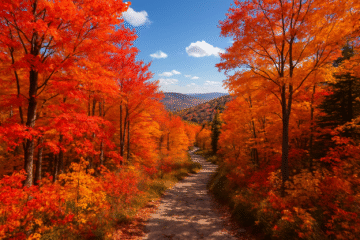There’s something magical about watching children discover the world around them. I’ll never forget the day I saw a group of kids huddled around a log, excitedly pointing at pill bugs crawling underneath. It was a simple moment, but it reminded me how nature can be the most dynamic classroom of all.
Charlotte Mason, a pioneer in education, once said, “It is infinitely well worth the mother’s while to take some pains every day to secure… hours daily amongst rural and natural objects.” Her philosophy resonates deeply with me. Consistent time spent outdoors fosters curiosity, creativity, and a love for learning.
From scavenger hunts to leaf rubbings, there are countless ways to blend play with discovery. These activities aren’t just fun—they teach biology, ecology, and sensory awareness. Whether you’re in a bustling city or a quiet countryside, these ideas can be adapted to any environment and age group.
Key Takeaways
- Nature provides endless opportunities for hands-on learning.
- Charlotte Mason emphasized the importance of daily outdoor time.
- Activities like scavenger hunts engage kids in meaningful ways.
- Outdoor experiences can be tailored to urban or rural settings.
- Simple moments in nature can spark curiosity and creativity.
1. The Importance of Outdoor Learning for Kids
The world outside is a treasure trove of lessons waiting to be uncovered. Unlike the sterile walls of a traditional classroom, nature offers a multisensory experience that engages kids in ways textbooks never could. Imagine the dappled sunlight filtering through tree canopies or the sound of leaves rustling in the wind—these moments spark curiosity and creativity.

Why Nature is the Best Classroom
Nature provides a hands-on approach to learning that’s hard to replicate indoors. Activities like measuring tree growth rings or observing seasonal changes teach children about biology and ecology in a tangible way. Research shows that students who participate in outdoor programs, like ForestNation’s Tree Kits, see a 63% improvement in science test scores. The world becomes their lab, and every discovery fuels their desire to learn more.
Benefits of Outdoor Activities for Child Development
Outdoor activities don’t just enhance academic skills—they also foster emotional growth. For instance, overcoming a fear of handling earthworms can build confidence and resilience. Studies reveal that kids who spend time outside sustain focus for up to 40 minutes longer during lessons. Programs like ForestNation’s schoolyard reforestation projects also teach teamwork and environmental stewardship. These experiences shape well-rounded individuals with a deep appreciation for the natural world.
For more insights on why outdoor education is essential, explore this resource. It’s clear that stepping outside isn’t just fun—it’s a powerful way to nurture young minds.
2. Daily Nature Walks: A Simple Yet Effective Activity
Every step outdoors is a chance to uncover something new. Whether it’s spotting a bird’s nest or identifying different types of leaves, daily walks in nature can be both relaxing and enriching. These activities don’t require much planning—just a willingness to observe and explore.

One of my favorite memories is discovering owl pellets during an evening walk. It was a simple moment, but it sparked a conversation about food chains and ecosystems. These small discoveries make every walk an adventure.
How to Make Nature Walks Educational
Transform ordinary walks into learning experiences with a few creative ideas. Try an “I Spy Biodiversity” game, where kids count insect species or identify plant varieties. This turns a stroll into a mini scavenger hunt.
Another fun project is making field journals from recycled materials. Use waterproof covers to protect them from the weather. Kids can sketch their findings or jot down observations, creating a personal guide to their discoveries.
Teach cloud identification using the Morning Time Menu’s weather chart system. It’s a great way to blend science with outdoor time. These activities make learning feel like play.
What to Bring on a Nature Walk
Packing the right items can enhance the experience. A magnifying glass helps kids examine tiny details, like the veins on a leaf. Specimen bags are perfect for collecting interesting finds, like feathers or seeds.
Don’t forget homemade trail mix for energy—it’s a tasty way to keep everyone going. With these essentials, every walk becomes a journey of discovery.
3. Adopt a Tree: Observing Seasonal Changes
Adopting a tree is like making a lifelong friend—it grows with you, changes with the seasons, and teaches you about resilience. This simple yet profound activity connects you to the rhythms of nature and offers endless opportunities for discovery.

How to Choose the Right Tree
Start by selecting a tree that’s easily accessible, like one in your backyard or a nearby park. Look for species with distinctive seasonal changes, such as maples or oaks. These plants provide a clear view of nature’s cycles, from budding leaves in spring to vibrant colors in fall.
Consider the tree’s size and age. Younger trees are easier to measure and track, while older ones offer a richer history. Tools like ForestNation Tree Kits can help you get started, providing everything you need to care for and observe your adopted tree.
Activities to Do with Your Adopted Tree
Once you’ve chosen your tree, the real fun begins. Try bark rubbing using charcoal from campfires to create unique art pieces. This simple technique highlights the tree’s texture and makes for a memorable keepsake.
Track sap production changes using basic measurement tools. This teaches kids about the life processes of trees. You can also calculate the tree’s estimated age by measuring its trunk circumference—a great way to incorporate math into your outdoor activities.
One inspiring example is a classroom that mapped 47 adopted trees, creating a detailed guide to their local garden. This project not only taught students about ecology but also fostered teamwork and creativity.
4. Nature Counting Scavenger Hunt
Scavenger hunts turn every walk into a treasure hunt of discovery. They’re a fantastic way to engage kids in learning while exploring the natural world. Whether you’re in a forest or an urban park, these activities spark curiosity and teach valuable skills.

Creating a Checklist for Your Scavenger Hunt
Start by downloading a printable checklist with 25 common and rare items to find. Include things like pinecones, feathers, and unique leaf shapes. This checklist turns the hunt into a structured yet fun adventure.
For urban environments, adapt the list to include lichen patterns or sidewalk cracks. This ensures the activity is accessible to everyone, no matter where they live.
Educational Benefits of Scavenger Hunts
Scavenger hunts teach classification systems. For example, counting pinecone scales can double as a math lesson. Sorting found objects by color or texture enhances observational skills.
One of my favorite memories is when kids discovered a bird’s nest with blue eggshells. It sparked a lively discussion about bird species and their habitats. These moments make learning unforgettable.
| Item | Educational Value |
|---|---|
| Pinecone | Math (counting scales), biology (seed dispersal) |
| Feather | Science (bird anatomy), art (drawing textures) |
| Leaf | Botany (leaf shapes), art (leaf rubbings) |
| Lichen | Ecology (symbiotic relationships), urban nature study |
Scavenger hunts are more than just fun—they’re a gateway to understanding the natural world. With a little creativity, every hunt becomes a memorable adventure.
5. Leaf Rubbings: Exploring Leaf Anatomy
Leaves are more than just part of a plant—they’re a canvas for creativity and discovery. Leaf rubbings are a simple yet fascinating way to explore the anatomy of plants while creating beautiful art. This activity is perfect for sparking curiosity about the natural world and teaching kids about the intricate structures of leaves.

How to Make Leaf Rubbings
Gather materials like paper, crayons, and leaves. Place a leaf under the paper and gently rub a crayon over it. The veins and edges of the leaf will appear, creating a detailed imprint. This activity builds observation and fine motor skills while allowing kids to express their creativity.
Learning About Leaf Structures
Leaf rubbings are more than just fun—they’re educational. Compare the structures of leaves from five common deciduous trees, like maples and oaks. Teach kids about margin patterns and venation, turning each rubbing into a mini science lesson.
Preserve your rubbings by coating them with beeswax. This technique not only protects the art but also introduces kids to basic preservation methods. For an added twist, experiment with natural dyes made from crushed leaves, blending chemistry with creativity.
One memorable example is an art gallery event where children exhibited their framed rubbings. This showcased their skills and deepened their connection to the natural world. Leaf rubbings are a simple yet powerful way to explore the beauty and complexity of leaves.
| Activity | Educational Value |
|---|---|
| Leaf Rubbing | Art (creativity), botany (leaf anatomy) |
| Preservation | Science (preservation techniques), art (longevity) |
| Natural Dyes | Chemistry (dye extraction), art (color exploration) |
6. Toy Wash: Combining Fun and Learning
Turning everyday tasks into adventures can spark joy and curiosity in children. A toy wash station is a perfect example—it’s not just about cleaning; it’s about discovery, creativity, and hands-on learning. Watching kids scrub away dirt while exploring the science of soap bubbles is both entertaining and educational.

Setting Up a Toy Wash Station
Creating a toy wash station is simple and requires minimal materials. Start with a large basin or bucket filled with water. Add a few drops of eco-friendly soap and provide sponges, brushes, and towels. Designate specific “exploration toys” for muddy play, like action figures or plastic animals, to make the activity more engaging.
For an extra layer of learning, incorporate a mud kitchen recipe. Mix soil and water to create mud, and let kids “cook” before washing their creations. This adds a sensory element to the activities and encourages imaginative play.
What Kids Can Learn from Washing Toys
Washing toys isn’t just about cleanliness—it’s a lesson in science, conservation, and fine motor skills. Demonstrate how soap breaks down dirt by creating bubble experiments. Use measured buckets to teach water conservation, showing kids how to use resources wisely.
One memorable moment was when a group of kids turned their action figures into mud sculptures. They laughed as they scrubbed away the dirt, learning about textures and cleaning techniques. Tracking water temperature changes also introduces basic measurement skills, making the activity both practical and fun.
| Activity | Learning Outcome |
|---|---|
| Soap Bubble Experiment | Science (surface tension, chemical reactions) |
| Water Conservation | Environmental awareness, resource management |
| Mud Sculptures | Creativity, sensory exploration |
| Temperature Tracking | Math (measurement), science (thermal changes) |
7. Gardening Together: Planting Seeds and Watching Them Grow
Watching a tiny seed sprout into a thriving plant feels like witnessing a miracle. Gardening with kids is one of the most rewarding activities—it teaches patience, responsibility, and the beauty of growth. Whether you’re planting herbs in a windowsill or creating a backyard garden, this hands-on experience connects children to the natural world in a meaningful way.

Choosing the Right Plants for Kids
Start with fast-growing plants that keep kids engaged. Rainbow chard, moonflowers, and sunflowers are excellent choices. These seeds sprout quickly, offering visible progress that excites young gardeners. For a fun twist, try milkweed—it attracts butterflies, turning your garden into a wildlife haven.
Create a DIY greenhouse using recycled soda bottles. This simple project teaches sustainability while protecting delicate seedlings. Track growth metrics in nature journals with hand-drawn charts, blending art and science. One inspiring example is a wheelchair-accessible garden bed project that brought joy and inclusivity to a local school.
Teaching Kids About the Plant Life Cycle
Gardening is a hands-on way to explore the life cycle of plants. From planting seeds to harvesting, kids witness every stage. Use The Peaceful Press Cookbook recipes to incorporate taste tests with homegrown herbs. This adds a sensory element to their learning experience.
Encourage kids to observe changes daily. Discuss how sunlight, water, and soil affect growth. This fosters curiosity and critical thinking. Gardening isn’t just about growing plants—it’s about nurturing young minds.
| Plant | Growth Time | Educational Value |
|---|---|---|
| Rainbow Chard | 3-4 weeks | Nutrition, color recognition |
| Moonflowers | 6-8 weeks | Nighttime pollination, botany |
| Sunflowers | 10-12 weeks | Plant height tracking, ecology |
| Milkweed | 4-6 weeks | Butterfly life cycle, conservation |
8. Bird Watching: Connecting with Feathered Friends
Birds have a way of capturing our attention with their songs and vibrant colors. Whether it’s the cheerful chirp of a sparrow or the majestic flight of a hawk, these animals bring life to any outdoor space. Bird watching is more than just a hobby—it’s a chance to connect with nature and learn about the delicate balance of ecosystems.

How to Start Bird Watching with Kids
Introducing kids to bird watching is easier than you might think. Begin by identifying common backyard birds like robins, cardinals, and blue jays. Their distinctive songs and colors make them easy to spot. Teach kids silent observation techniques using homemade blinds—a simple setup of sheets and sticks can turn your backyard into a bird-watching haven.
One of my favorite moments was when a group of school kids spotted a rare indigo bunting. Their excitement was contagious, and it sparked a lively discussion about migration patterns. These moments make bird watching unforgettable.
Making a Bird Feeder
Creating a bird feeder is a fun and practical activity that attracts feathered friends to your yard. Use pinecones, peanut butter, and birdseed for a simple DIY feeder. Spread peanut butter on the pinecone, roll it in birdseed, and hang it from a tree branch. This project teaches kids about the needs of birds while encouraging creativity.
For a more advanced project, try building a birdhouse. Use safe, non-toxic materials and follow safety tips to ensure it’s a welcoming space for your avian visitors. Watching birds nest and raise their young is a rewarding experience for kids and adults alike.
| Seed Type | Birds Attracted | Benefits |
|---|---|---|
| Sunflower Seeds | Cardinals, Blue Jays | High in protein, easy to crack |
| Nyjer Seeds | Finches, Sparrows | Rich in oil, attracts small birds |
| Suet | Woodpeckers, Nuthatches | High energy, ideal for winter |
| Mixed Seeds | Variety of species | Offers balanced nutrition |
Bird watching isn’t just about observing—it’s about learning. Compare seed types through controlled feeding experiments to see which birds prefer what. Discuss the aerodynamics of different feather types, blending physics with nature study. These activities turn bird watching into a rich educational experience.
Whether you’re in your backyard or a local park, bird watching is a gateway to understanding the natural world. It’s a simple yet profound way to connect with animals and inspire a love for nature in kids.
9. Outdoor Arts and Crafts: Creativity in Nature
Creativity blooms when we step outside and let nature guide our hands. The natural world offers endless inspiration for artistic expression. From berry dye paintings to land art installations, these activities blend creativity with a deep connection to the world.

Nature-Inspired Art Projects
One of my favorite projects is creating temporary mandalas using seasonal materials. Gather items like leaves, twigs, and stones for your creations. Arrange them in symmetrical patterns to incorporate geometry into your art. These designs are ephemeral, reminding us of the beauty in impermanence.
Another memorable activity is natural papermaking. Use recycled junk mail and plant fibers to craft unique sheets. This teaches sustainability while sparking creativity. Each creation tells a story of the earth’s beauty and resilience.
Using Natural Materials for Crafts
Using natural materials for crafts is both sustainable and inspiring. Host outdoor art shows with biodegradable installations. These displays celebrate the world around us while leaving no trace behind.
One of my most cherished memories is an “ephemeral art” lesson using autumn leaves. We created intricate patterns on the forest floor, blending art with the changing seasons. Let the world around you inspire your next masterpiece.
- Create temporary mandalas using seasonal materials.
- Demonstrate natural papermaking with recycled junk mail.
- Host outdoor art shows with biodegradable installations.
- Share memorable “ephemeral art” lessons using autumn leaves.
- Incorporate geometry through symmetrical nature patterns.
10. Conclusion: Embrace Nature’s Classroom
The beauty of nature lies in its ability to transform simple moments into lifelong memories. Watching tadpoles morph into frogs or leaves change with the seasons reminds us of the world’s endless wonders. These experiences aren’t just for kids—they’re for anyone willing to pause and observe.
On rainy days, bring the nature indoors. Create a home nature journal to document your discoveries. Share it with friends or family to build a community of curious minds. Programs like ForestNation have planted over 18,000 trees through school initiatives, showing how small actions can make a big impact.
Let’s continue this conversation. Share your stories and inspire others to explore the adventures waiting outside. For more ideas, check out these outdoor learning activities. Together, we can foster a deeper connection to the world around us.



0 Comments